Recent Climatology (1991–2020) and Trends in Local Warm and Cold Season Extreme Temperature Days and Nights in Arabia
Abstract
:1. Introduction
2. Data and Methods
2.1. Data and Quality Control
2.2. Homogeneity
2.3. Thermal Extreme Indices and Extreme Season Definitions
2.4. Trend Analysis
3. Results and Discussion
3.1. Evaluation
3.2. Implications
3.3. Extreme Warm Day and Night Behavior
3.4. Extreme Cold Day and Night Behavior
3.5. Trends
4. Summary and Conclusions
Supplementary Materials
Funding
Institutional Review Board Statement
Informed Consent Statement
Data Availability Statement
Conflicts of Interest
References
- Cook, K.H.; Vizy, E.K.; Liu, Y.; Liu, W. Greenhouse-gas induced warming amplification over the arabian peninsula with implications for Ethiopian rainfall. Clim. Dyn. 2021, 57, 3113–3133. [Google Scholar] [CrossRef]
- Dogar, M.M.; Sato, T. Analysis of climate trends and leading modes of climate variability for MENA region. J. Geophys. Res. Atmos. 2018, 123, 13074–13091. [Google Scholar] [CrossRef]
- Attada, R.; Dasari, H.P.; Chowdary, J.S.; Yadav, R.K.; Knio, O.; Hoteit, I. Surface air temperature variability over the Arabian Peninsula and its links to circulation patterns. Int. J. Climatol. 2019, 39, 445–464. [Google Scholar] [CrossRef]
- Odnoletkova, N.; Patzek, T.W. Data-driven analysis of climate change in Saudi Arabia: Trends in temperature extremes and human comfort indicators. J. Appl. Meteorol. Climatol. 2021, 60, 1055–1070. [Google Scholar] [CrossRef]
- Almazroui, M. Temperature changes over the CORDEX-MENA domain in the 21st century using CMIP5 data downscaled with RegCM4: A focus on the Arabian Peninsula. Adv. Meteorol. 2019, 2019, 5395676. [Google Scholar] [CrossRef] [Green Version]
- Almazroui, M.; Islam, M.N.; Saeed, S.; Saeed, F.; Ismail, M. Future changes in climate over the Arabian Peninsula based on CMIP6 multimodel simulations. Earth Syst. Environ. 2020, 4, 611–630. [Google Scholar] [CrossRef]
- Pal, J.S.; Eltahir, E.A.B. Future temperature in southwest Asia Projected to exceed a threshold for human adaptability. Nat. Clim. Chang. 2016, 6, 197–200. [Google Scholar] [CrossRef]
- Sheridan, S.C.; Lee, C.C. Temporal trends in absolute and relative extreme temperature events across north America. J. Geophys. Res. Atmos. 2018, 123, 11889–11898. [Google Scholar] [CrossRef]
- Aguilar, E.; Peterson, T.C.; Obando, P.R.; Frutos, R.; Retana, J.A.; Solera, M.; Soley, J.; García, I.G.; Araujo, R.M.; Santos, A.R.; et al. Changes in precipitation and temperature extremes in central America and northern south America, 1961–2003. J. Geophys. Res. 2005, 110, D23107. [Google Scholar] [CrossRef]
- Nasrallah, H.A.; Nieplova, E.; Ramadan, E. Warm season extreme temperature events in Kuwait. J. Arid Environ. 2004, 56, 357–371. [Google Scholar] [CrossRef]
- Almazroui, M.; Islam, M.N.; Athar, H.; Jones, P.D.; Rahman, M.A. Recent climate change in the Arabian Peninsula: Annual rainfall and temperature analysis of Saudi Arabia for 1978–2009. Int. J. Climatol. 2012, 32, 953–966. [Google Scholar] [CrossRef]
- Almazroui, M.; Islam, M.N.; Jones, P.D.; Athar, H.; Rahman, M.A. Recent climate change in the Arabian Peninsula: Seasonal rainfall and temperature climatology of Saudi Arabia for 1979–2009. Atmos. Res. 2012, 111, 29–45. [Google Scholar] [CrossRef]
- Almazroui, M.; Islam, M.N.; Dambul, R.; Jones, P.D. Trends of temperature extremes in Saudi Arabia. Int. J. Climatol. 2014, 34, 808–826. [Google Scholar] [CrossRef]
- AlSarmi, S.H.; Washington, R. Changes in climate extremes in the Arabian Peninsula: Analysis of daily data: Changes extremes over Arabia. Int. J. Climatol. 2014, 34, 1329–1345. [Google Scholar] [CrossRef]
- Athar, H. Trends in observed extreme climate indices in Saudi Arabia during 1979–2008. Int. J. Climatol. 2014, 34, 1561–1574. [Google Scholar] [CrossRef]
- Zhang, X.; Aguilar, E.; Sensoy, S.; Melkonyan, H.; Tagiyeva, U.; Ahmed, N.; Kutaladze, N.; Rahimzadeh, F.; Taghipour, A.; Hantosh, T.H.; et al. Trends in middle east climate extreme indices from 1950 to 2003. J. Geophys. Res. 2005, 110, D22104. [Google Scholar] [CrossRef]
- Donat, M.G.; Peterson, T.C.; Brunet, M.; King, A.D.; Almazroui, M.; Kolli, R.K.; Boucherf, D.; Al-Mulla, A.Y.; Nour, A.Y.; Aly, A.A.; et al. Changes in extreme temperature and precipitation in the Arab region: Long-term trends and variability related to ENSO and NAO. Int. J. Climatol. 2014, 34, 581–592. [Google Scholar] [CrossRef]
- Almazroui, M. Changes in temperature trends and extremes over Saudi Arabia for the period 1978–2019. Adv. Meteorol. 2020, 2020, 8828421. [Google Scholar] [CrossRef]
- Almazroui, M.; Saeed, F.; Islam, M.N.; Alkhalaf, A.K. Assessing the robustness and uncertainties of projected changes in temperature and precipitation in AR4 global climate models over the Arabian Peninsula. Atmos. Res. 2016, 182, 163–175. [Google Scholar] [CrossRef]
- Perkins, S.E.; Alexander, L.V. On the measurement of heat waves. J. Clim. 2013, 26, 4500–4517. [Google Scholar] [CrossRef]
- Chen, Y.; Zhai, P. Revisiting summertime hot extremes in China during 1961–2015: Overlooked compound extremes and significant changes. Geophys. Res. Lett. 2017, 44, 5096–5103. [Google Scholar] [CrossRef]
- Smith, E.T.; Sheridan, S.C. The characteristics of extreme cold events and cold air outbreaks in the eastern United States. Int. J. Climatol. 2018, 38, e807–e820. [Google Scholar] [CrossRef]
- Alghamdi, A.S.; Harrington, J. Time-sensitive analysis of a warming climate on heat waves in Saudi Arabia: Temporal patterns and trends. Int. J. Climatol. 2018, 38, 3123–3139. [Google Scholar] [CrossRef]
- Alpert, P.; Osetinsky, I.; Ziv, B.; Shafir, H. A new seasons definition based on classified daily synoptic systems: An example for the eastern Mediterranean. Int. J. Climatol. 2004, 24, 1013–1021. [Google Scholar] [CrossRef]
- Kotsias, G.; Lolis, C.J.; Hatzianastassiou, N.; Lionello, P.; Bartzokas, A. An objective definition of seasons for the Mediterranean region. Int. J. Climatol. 2021, 41, E1889–E1905. [Google Scholar] [CrossRef]
- Sparks, T.H.; Menzel, A. Observed changes in seasons: An overview. Int. J. Climatol. 2002, 22, 1715–1725. [Google Scholar] [CrossRef]
- Zander, R.; Messina, A.; Godek, M. An air mass based approach to the establishment of spring season synoptic characteristics in the northeast United States. Atmos. Clim. Sci. 2013, 3, 408–419. [Google Scholar] [CrossRef] [Green Version]
- Allen, M.J.; Sheridan, S.C. Evaluating changes in season length, onset, and end dates across the United States (1948–2012). Int. J. Climatol. 2016, 36, 1268–1277. [Google Scholar] [CrossRef]
- Harrington, L.J. Rethinking extreme heat in a cool climate: A New Zealand case study. Environ. Res. Lett. 2020, 16, 034030. [Google Scholar] [CrossRef]
- Lee, C.C.; Obarein, O.; Sheridan, S.C.; Smith, E.T.; Adams, R. Examining trends in multiple parameters of seasonally-relative extreme temperature and dew point events across north America. Int. J. Climatol. 2021, 41, E2360–E2378. [Google Scholar] [CrossRef]
- Dunn, R.J.H.; Willett, K.M.; Thorne, P.W.; Woolley, E.V.; Durre, I.; Dai, A.; Parker, D.E.; Vose, R.S. HadISD: A quality-controlled global synoptic report database for selected variables at long-term stations from 1973–2011. Clim. Past 2012, 8, 1649–1679. [Google Scholar] [CrossRef] [Green Version]
- Dunn, R.J.H.; Willett, K.M.; Parker, D.E.; Mitchell, L. Expanding HadISD: Quality-controlled, sub-daily station data from 1931. Geosci. Instrum. Methods Data Syst. 2016, 5, 473–491. [Google Scholar] [CrossRef] [Green Version]
- McGree, S.; Herold, N.; Alexander, L.; Schreider, S.; Kuleshov, Y.; Ene, E.; Finaulahi, S.; Inape, K.; Mackenzie, B.; Malala, H.; et al. Recent changes in mean and extreme temperature and precipitation in the western Pacific islands. J. Clim. 2019, 32, 4919–4941. [Google Scholar] [CrossRef]
- Abdullah, A.Y.M.; Bhuian, M.H.; Kiselev, G.; Dewan, A.; Hasan, Q.K.; Rafiuddin, M. Extreme temperature and rainfall events in Bangladesh: A comparison between coastal and inland areas. Int. J. Climatol. 2020, 6911. [Google Scholar] [CrossRef]
- Wang, X.L. Accounting for autocorrelation in detecting mean shifts in climate data series using the penalized maximal T or F test. J. Appl. Meteorol. Climatol. 2008, 47, 2423–2444. [Google Scholar] [CrossRef]
- Wang, X.L. Penalized maximal F test for detecting undocumented mean shift without trend change. J. Atmos. Ocean. Technol. 2008, 25, 368–384. [Google Scholar] [CrossRef]
- Wang, X.; Feng, Y. RHtests V4 User Manual; Climate Research Division Atmospheric Science and Technology Directorate Science and Technology Branch, Environment Canada: Toronto, ON, Canada, 2013.
- Yosef, Y.; Aguilar, E.; Alpert, P. Changes in extreme temperature and precipitation indices: Using an innovative daily homogenized database in Israel. Int. J. Climatol. 2019, 39, 5022–5045. [Google Scholar] [CrossRef]
- Vincent, L.A.; Milewska, E.J.; Wang, X.L.; Hartwell, M.M. Uncertainty in homogenized daily temperatures and derived indices of extremes illustrated using parallel observations in Canada: Uncertainty in homogenized daily temperatures and extremes in Canada. Int. J. Climatol. 2018, 38, 692–707. [Google Scholar] [CrossRef] [Green Version]
- World Meteorological Organization. Guidelines on Homogenization; World Meteorological Organization: Geneva, Switzerland, 2020. [Google Scholar]
- Trewin, B.; Braganza, K.; Fawcett, R.; Grainger, S.; Jovanovic, B.; Jones, D.; Martin, D.; Smalley, R.; Webb, V. An updated long-term homogenized daily temperature data set for Australia. Geosci. Data J. 2020, 7, 149–169. [Google Scholar] [CrossRef]
- Fowler, D.B. Cold acclimation threshold induction temperatures in cereals. Crop. Sci. 2008, 48, 1147. [Google Scholar] [CrossRef]
- Smith, E.T.; Sheridan, S.C. The influence of extreme cold events on mortality in the United States. Sci. Total Environ. 2019, 647, 342–351. [Google Scholar] [CrossRef]
- Sheridan, S.C.; Lee, C.C.; Allen, M.J. The mortality response to absolute and relative temperature extremes. Int. J. Environ. Res. Public Health 2019, 16, 1493. [Google Scholar] [CrossRef] [Green Version]
- Nairn, J.; Fawcett, R. The excess heat factor: A metric for heatwave intensity and its use in classifying heatwave severity. Int. J. Environ. Res. Public Health 2014, 12, 227–253. [Google Scholar] [CrossRef] [PubMed] [Green Version]
- Sen, P.K. Estimates of the regression coefficient based on Kendall’s Tau. J. Am. Stat. Assoc. 1968, 63, 1379–1389. [Google Scholar] [CrossRef]
- Yue, S.; Pilon, P.; Phinney, B.; Cavadias, G. The influence of autocorrelation on the ability to detect trend in hydrological series. Hydrol. Process. 2002, 16, 1807–1829. [Google Scholar] [CrossRef]
- Rhines, A.; Huybers, P. Frequent summer temperature extremes reflect changes in the mean, not the variance. Proc. Natl. Acad. Sci. USA 2013, 110, E546. [Google Scholar] [CrossRef] [PubMed] [Green Version]
- Tingley, M.P.; Huybers, P. Recent temperature extremes at high northern latitudes unprecedented in the past 600 years. Nature 2013, 496, 201–205. [Google Scholar] [CrossRef]
- McKinnon, K.A.; Rhines, A.; Tingley, M.P.; Huybers, P. The changing shape of northern hemisphere summer temperature distributions. J. Geophys. Res. Atmos. 2016, 121, 8849–8868. [Google Scholar] [CrossRef]
- van der Wiel, K.; Bintanja, R. Contribution of climatic changes in mean and variability to monthly temperature and precipitation extremes. Commun. Earth Environ. 2021, 2, 1. [Google Scholar] [CrossRef]
- Alghamdi, A.S.; Harrington, J. Trends and spatial pattern recognition of warm season hot temperatures in Saudi Arabia. Theor. Appl. Climatol. 2019, 138, 793–807. [Google Scholar] [CrossRef]
- McElroy, S.; Schwarz, L.; Green, H.; Corcos, I.; Guirguis, K.; Gershunov, A.; Benmarhnia, T. Defining heat waves and extreme heat events using sub-regional meteorological data to maximize benefits of early warning systems to population health. Sci. Total Environ. 2020, 721, 137678. [Google Scholar] [CrossRef] [PubMed]
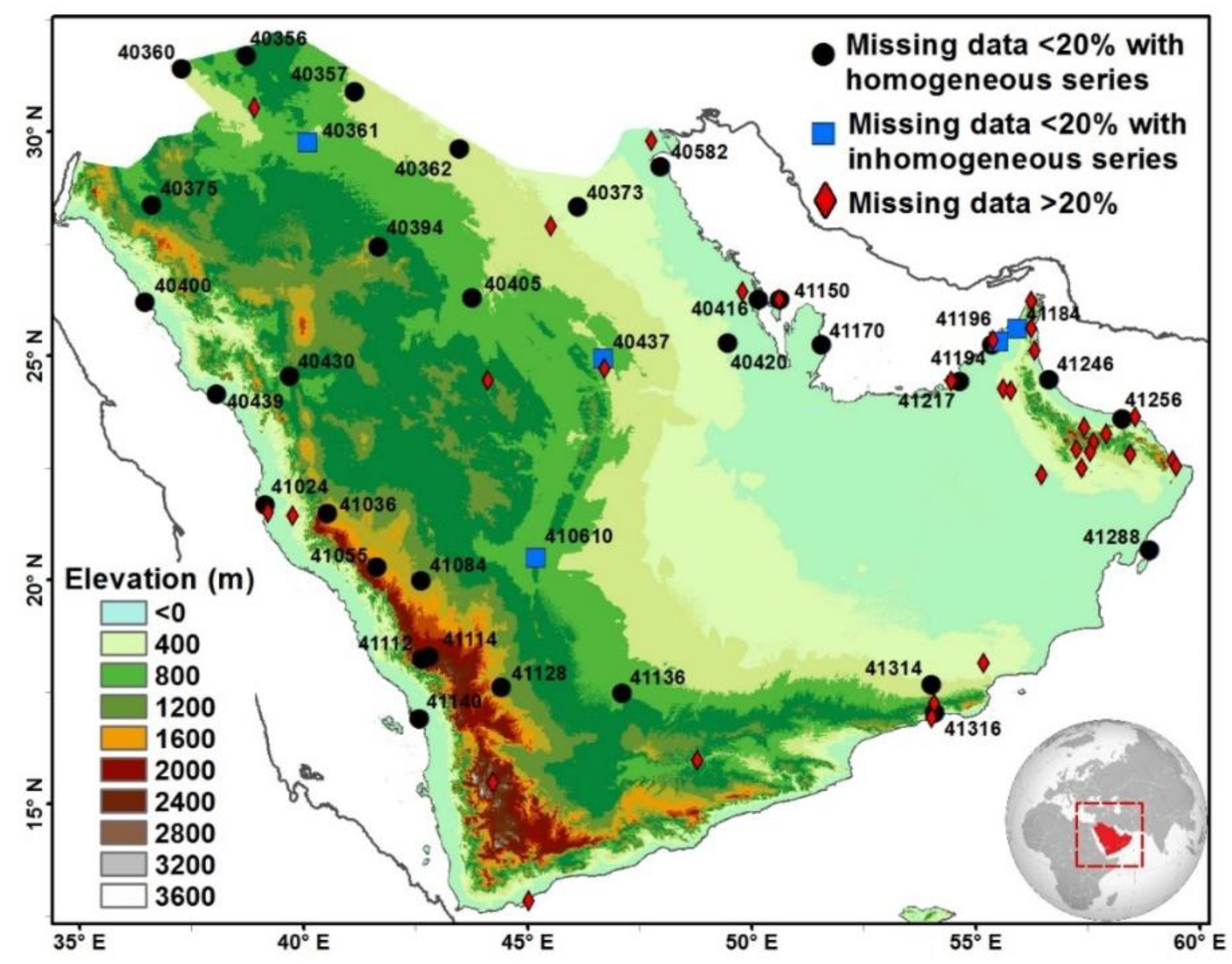
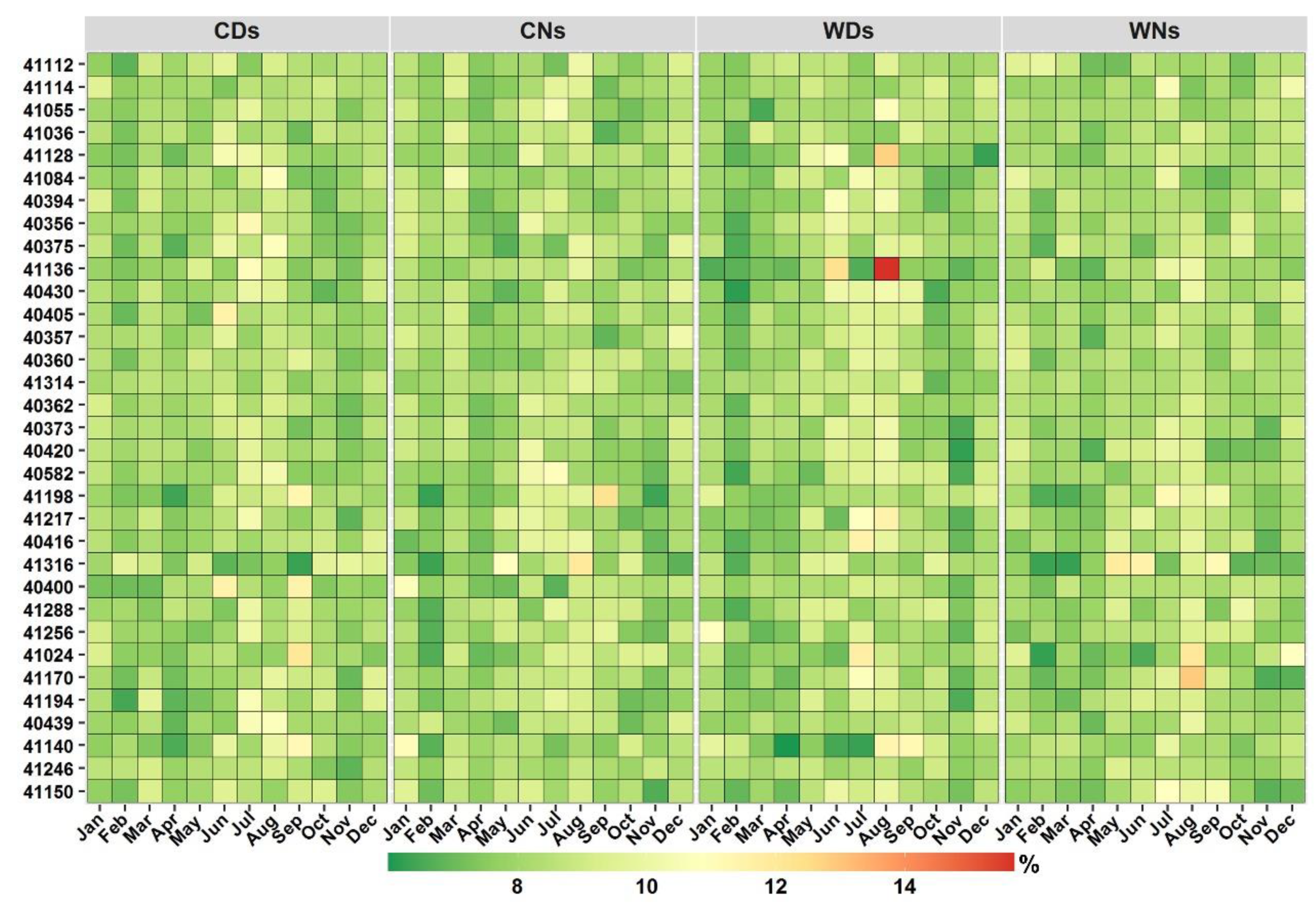
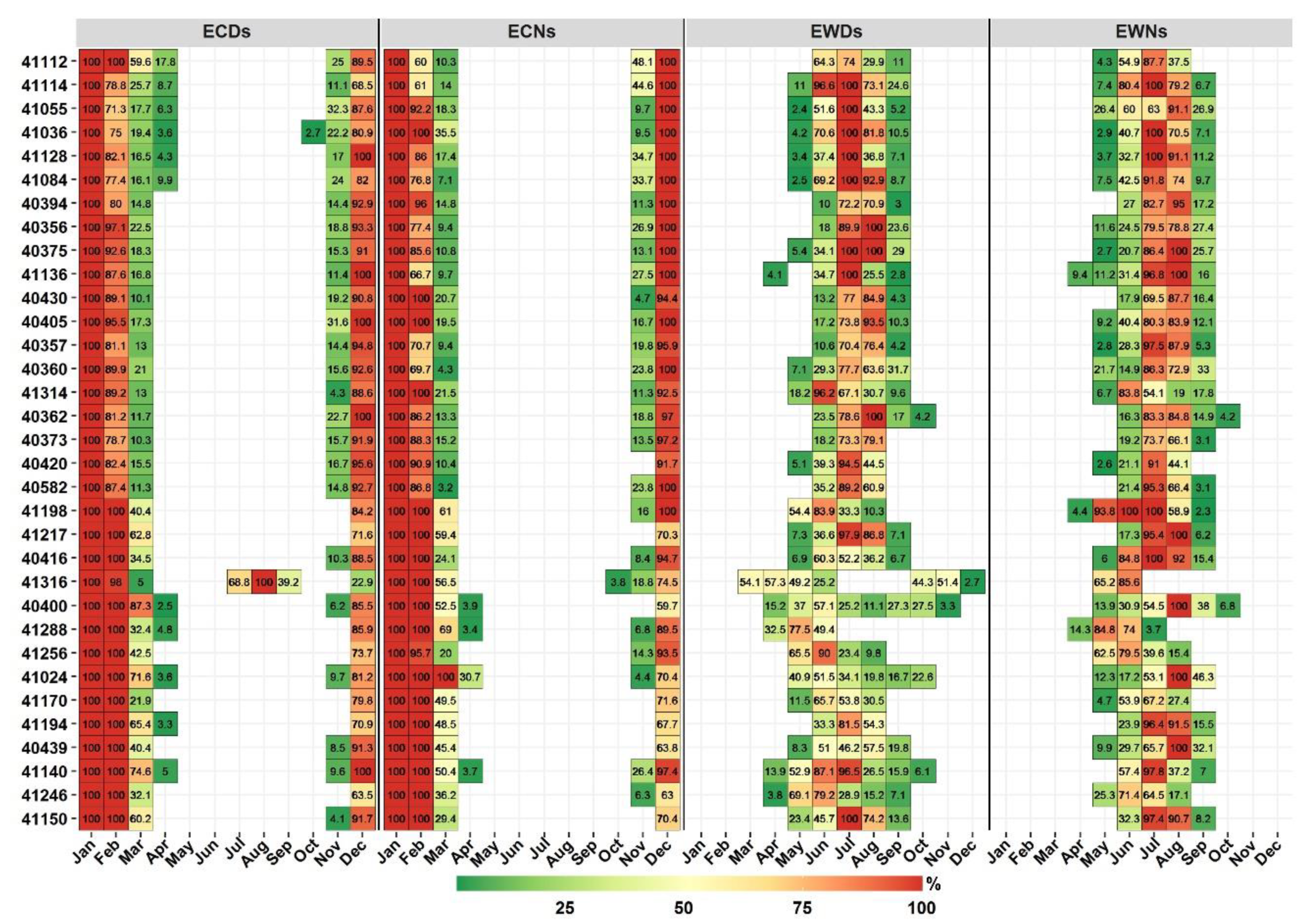

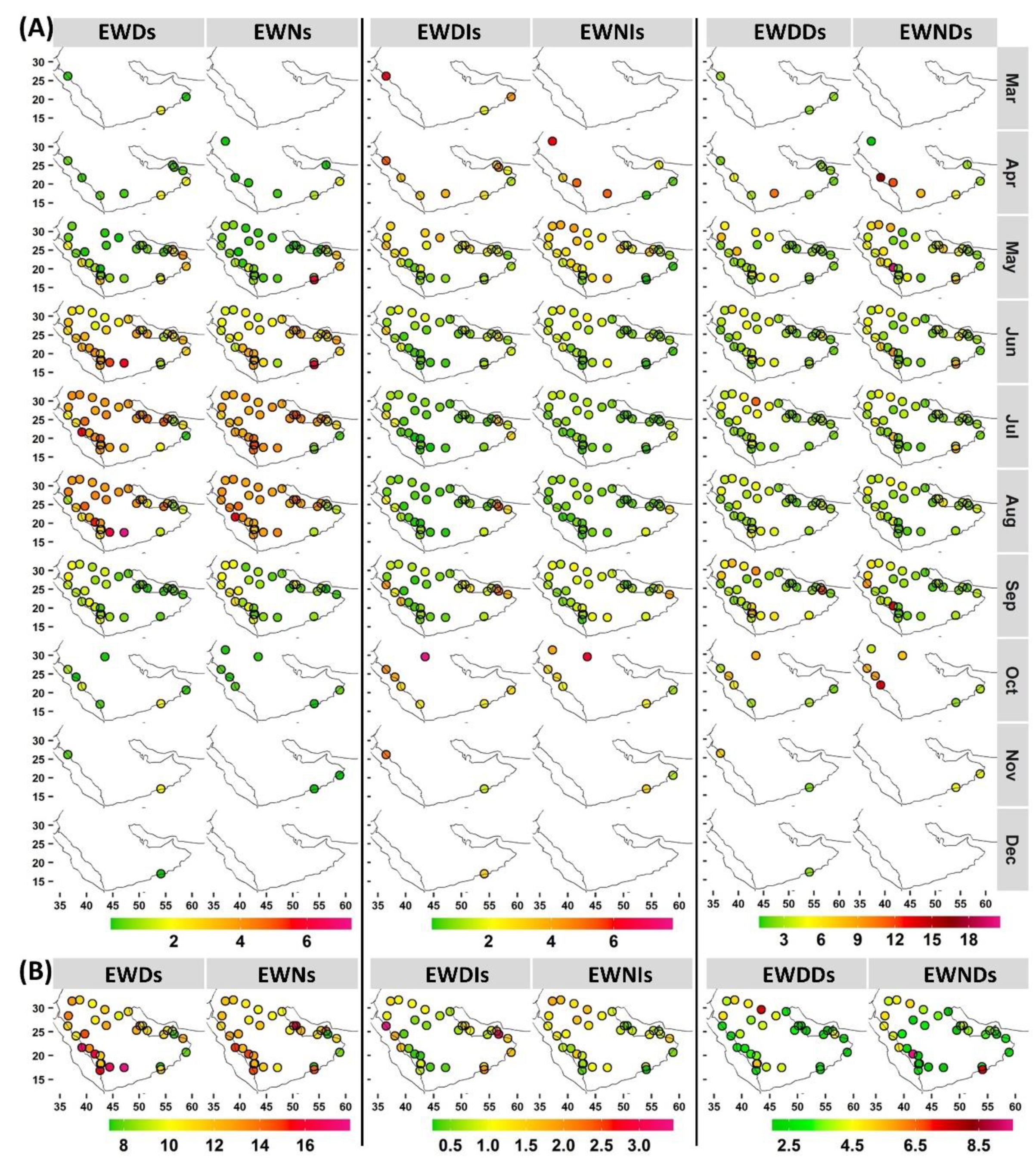
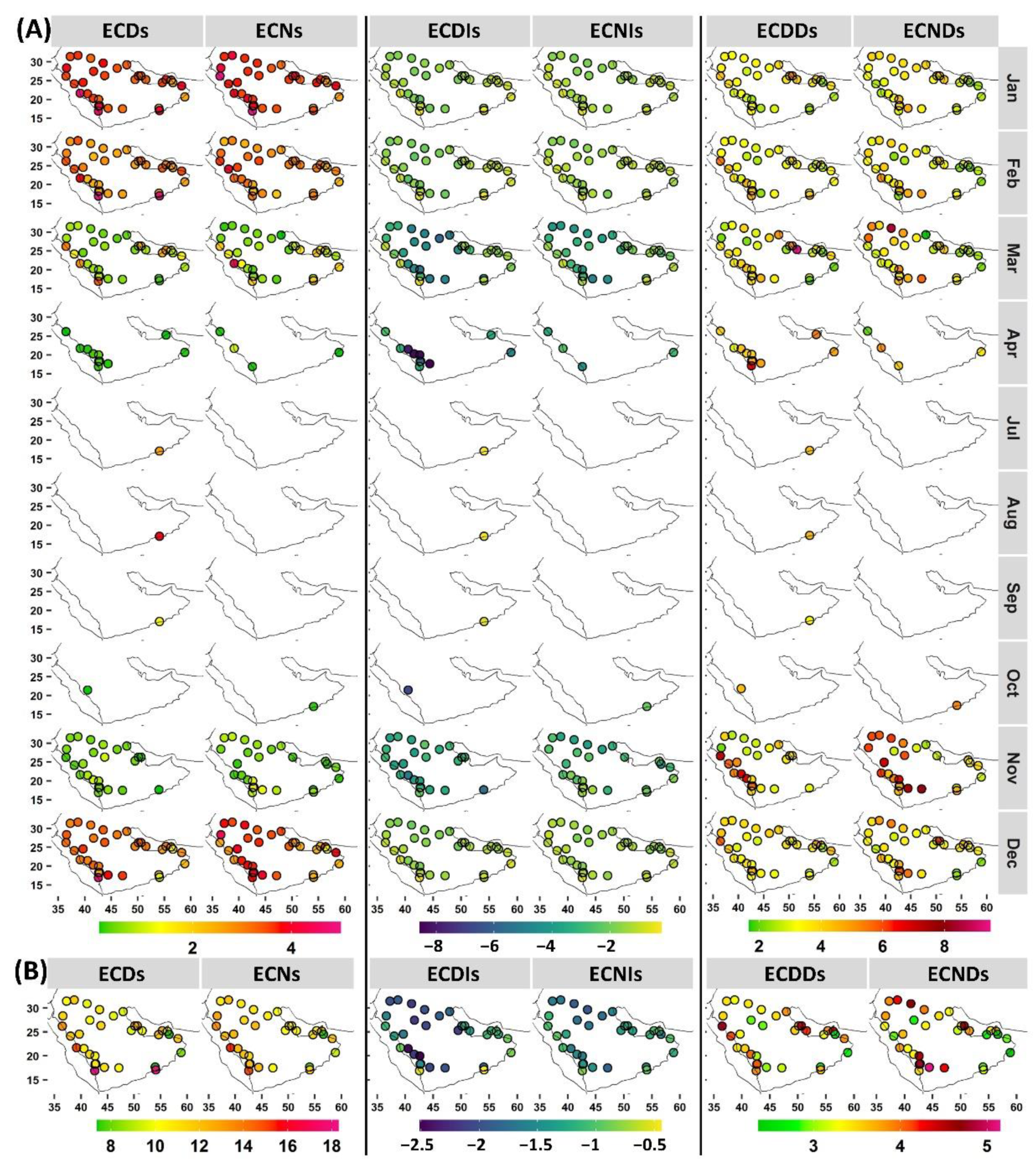
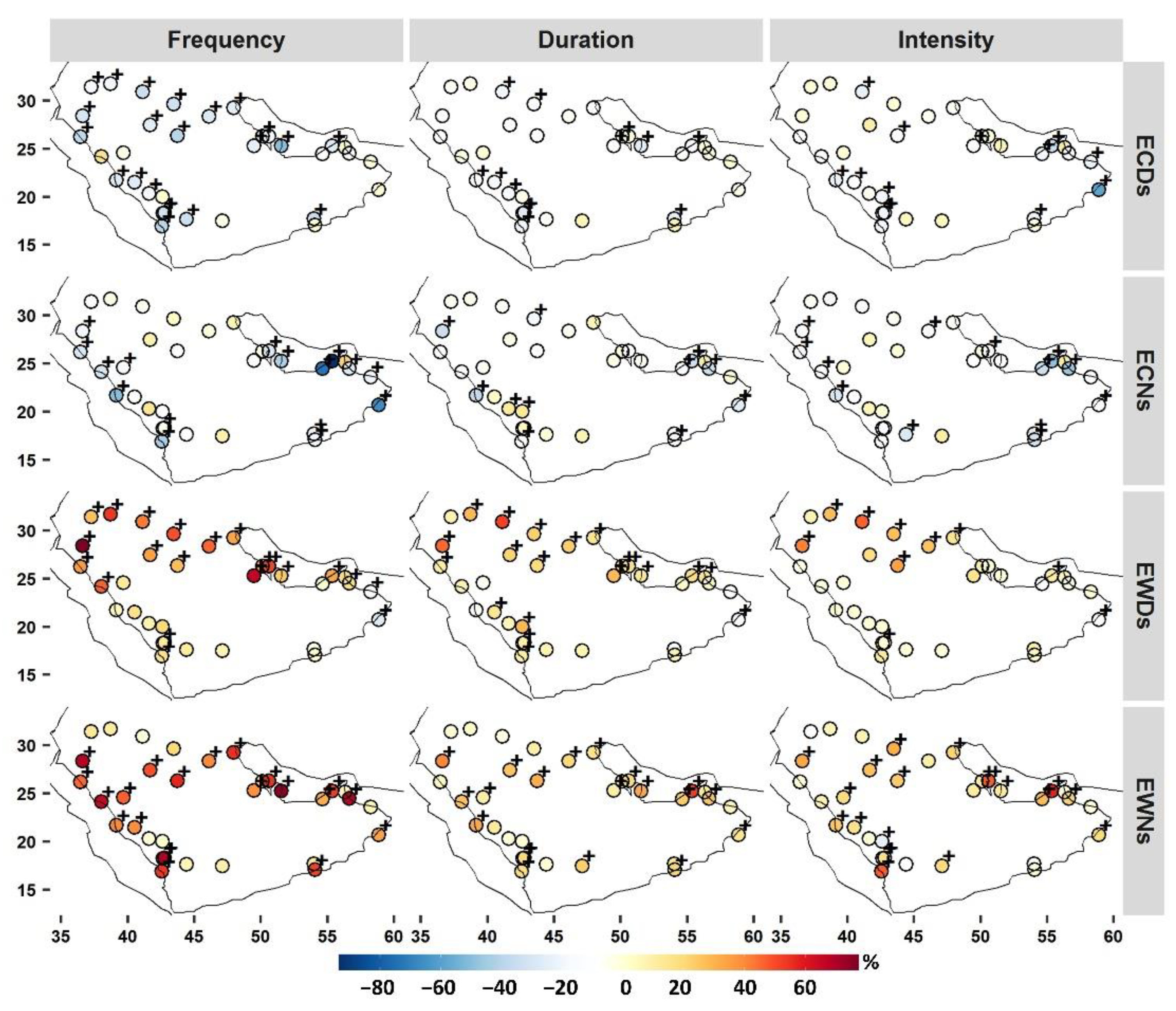
| No. | Indices | Name | Definition | Units |
|---|---|---|---|---|
| 1 | WD | Warm days | Days with TX ≥ 90th percentile. | Days |
| 2 | EWD | Extreme warm day frequency | Monthly number of events in which WD experiences TX ≥ 75th percentile of TX of WDs (WDT75th). | Days |
| 3 | EWDD | EWD duration | Mean length of consecutive occurrences of each EWD. | Days |
| 4 | EWDI | EWD intensity | Average difference between TX of each EWD and TX90th. | °C |
| 5 | WN | Warm nights | Nights with TN > 90th percentile. | Days |
| 6 | EWN | Extreme warm nights frequency | Monthly number of events in which WN experiences TN ≥ 75th percentile of TN of WNs (WNT75th). | Days |
| 7 | EWND | EWN duration | Mean length of consecutive occurrences of each EWN. | Days |
| 8 | EWNI | EWN intensity | Average difference between TN of each EWN and TN90th. | °C |
| 9 | CD | Cold days | Days with TX ≤ 10th percentile. | Days |
| 10 | ECD | Extreme cold days frequency | Monthly number of events in which CD experiences TX ≤ 25th percentile of TX of WDs (CDT25th). | Days |
| 11 | ECDD | ECD duration | Mean length of consecutive occurrences of each ECD. | Days |
| 12 | ECDI | ECD intensity | Average difference between TX of each ECD and TX10th. | °C |
| 13 | CN | Cold nights | Nights with TN ≤ 10th percentile. | Nights |
| 14 | ECNF | Extreme cold nights frequency | Monthly number of events in which CN experiences TN ≤ 25th percentile of TN of CNs (CNT25th). | Nights |
| 15 | ECND | ECN duration | Mean length of consecutive occurrences of each ECN. | Nights |
| 16 | ECNI | ECN intensity | Average difference between and TN of each ECN and TN10th. | °C |
Publisher’s Note: MDPI stays neutral with regard to jurisdictional claims in published maps and institutional affiliations. |
© 2022 by the author. Licensee MDPI, Basel, Switzerland. This article is an open access article distributed under the terms and conditions of the Creative Commons Attribution (CC BY) license (https://creativecommons.org/licenses/by/4.0/).
Share and Cite
Alghamdi, A.S. Recent Climatology (1991–2020) and Trends in Local Warm and Cold Season Extreme Temperature Days and Nights in Arabia. Int. J. Environ. Res. Public Health 2022, 19, 2506. https://doi.org/10.3390/ijerph19052506
Alghamdi AS. Recent Climatology (1991–2020) and Trends in Local Warm and Cold Season Extreme Temperature Days and Nights in Arabia. International Journal of Environmental Research and Public Health. 2022; 19(5):2506. https://doi.org/10.3390/ijerph19052506
Chicago/Turabian StyleAlghamdi, Ali S. 2022. "Recent Climatology (1991–2020) and Trends in Local Warm and Cold Season Extreme Temperature Days and Nights in Arabia" International Journal of Environmental Research and Public Health 19, no. 5: 2506. https://doi.org/10.3390/ijerph19052506






